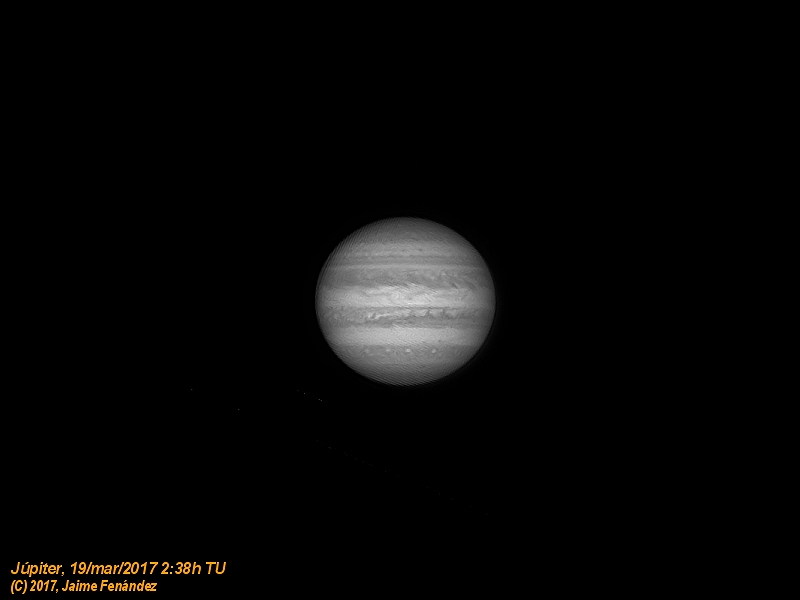
| |
| Júpiter - 19/3/2017
|
|
Jupiter
Júpiter, 19/mar/2017, 2:39h TU |
|
| |
Jupiter is the fifth planet from the Sun and the largest planet within the
Solar System. Jupiter is classified as a gas giant along with Saturn,
Uranus and Neptune.
Jupiter is primarily composed of hydrogen with a quarter of its mass being
helium; it may also have a rocky core of heavier elements. Because of its
rapid rotation, Jupiter's shape is that of an oblate spheroid. The outer
atmosphere is visibly segregated into several bands at different
latitudes, resulting in turbulence and storms along their interacting
boundaries. A prominent result is the Great Red Spot, a giant storm.
Surrounding the planet is a faint planetary ring system and a powerful
magnetosphere. There are also at least 64 moons, including the four
large moons called the Galilean moons that were first discovered by
Galileo Galilei in 1610.
Jupiter has been explored on several occasions by robotic spacecraft, most
notably during the early Pioneer and Voyager flyby missions and later by the
Galileo orbiter. The most recent probe to visit Jupiter was the New Horizons
spacecraft in late February 2007. The probe used the gravity from
Jupiter to increase its speed. Future targets for exploration in the
Jovian system include the possible ice-covered liquid ocean on the moon
Europa.
Some caracteristics:
Perihelion: 740,573,600 km (4.950429 AU)
Orbital period: 11.8618 yr
Satellites 64
Eq. radius 71,492 ± 4 km (11.209 Earths)
Mean density 1.326 g/cm3
Surface temp. 112-165 K
Composition: 89.8±2.0% hydrogen (H2)
10.2±2.0% helium
~0.3% methane
~0.026% ammonia
~0.003% hydrogen deuteride (HD)
0.0006% ethane
0.0004% water
Júpiter es el quinto planeta desde el Sol y el más grande dentro del Sistema
Solar. Júpiter está clasificado como un gigante gaseoso junto con Saturno,
Urano y Neptuno.
Júpiter está compuesto principalmente de hidrógeno con un cuarto de su
masa de helio; es posible que tenga un núcleo rocoso compuesto de elementos
más pesados. Júpiter presenta una forma esférica achatada a causa de su
rápida rotación. Se aprecia su atmósfera exterior dividida en varias
bandas a diferentes latitudes, con turbulencias y tormentas interactuando en
sus bordes. Un elemento destacado es la Gran Mancha Roja, una tormenta
gigante. Rodeando el planeta se encuentra un tenue anillo planetario y un
fuerte campo magnético. Hay además al menos 64 satélites, incluyendo las
cuatro lunas más grandes llamadas Galileanas gracias a su descubridor, Galileo
Galilei, en 1610.
Júpiter ha sido explorado en varias ocasiones por sondas espaciales, la más
notable de ellas durante los primeros sobrevuelos de las Pioneer y
Voyager, y posteriormente por el orbitador Galileo. New Horizons es la
última sonda que ha explorado el planeta en febrero de 2007. La sonda
aprovechó la gravedad de Júpiter para incrementar su velocidad. Los
próximos objetivos de exploración del sistema joviano incluyen el
estudio del posible océano líquido bajo la superficie helada de Europa.
Algunas características:
Perihelio: 740.573.600 km (4,950429 AU)
Periodo orbital: 11,8618 años
Satélites: 64
Radio ecuatorial 71.492 ± 4 km (11,209 Tierras)
Densidad media: 1,326 g/cm3
Temperatura: 112-165 K en superficie
Composición: 89,8±2,0% hidrógeno (H2)
10,2±2,0% helio
~0,3% metano
~0,026% amoniaco
~0,003% hidrógeno deuterio (HD)
0,0006% etano
0,0004% agua |
|
| |
| Technical details: |
|
Location: |
Castellar de Santiago - Spain |
Date: |
19/03/2017 (dd/mm/yyyy) |
Conditions: |
Bad |
Temperature: |
LowºC |
Humidity: |
|
|
|
Telescope: |
Celestron C14 f/10
|
Reducer/corrector: |
No reducer
|
Filter: |
Baader Neodimiun 1.25"
|
Mount: |
Celestron CGE
|
Camera: |
DMK 21AU618
|
Exposure: |
4000 frames @60fps |
Guiding tube: |
No guiding
|
Guiding camera: |
No guide camera
|
Guiding software: |
No guide software
|
|
|
Procesing: |
AutoStakkert!2 + Registax 6 + PixInsight |
|
Notes: |
|
|
| |
|
|
|
|

